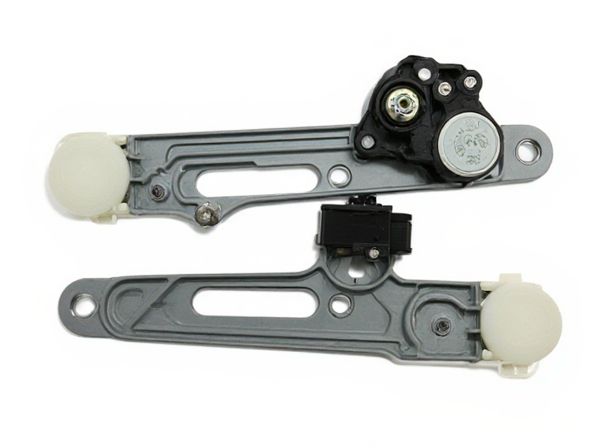
Photo illustration: Manual Window Regulator vs Power Window Regulator
Manual window regulators require physical effort to roll windows up or down, providing a simpler and more cost-effective solution for vehicle window control. Power window regulators use an electric motor, offering convenience and ease of operation with just a button press, making your driving experience more comfortable and efficient. Choosing between these depends on your preference for manual control versus automated functionality in your vehicle.
Table of Comparison
| Feature | Manual Window Regulator | Power Window Regulator |
|---|---|---|
| Operation | Crank handle | Electric motor |
| Installation Cost | Low | High |
| Maintenance | Simple, fewer parts | Complex, possible electrical issues |
| Convenience | Manual effort required | One-touch operation |
| Reliability | Durable and reliable | Can fail due to motor or switch faults |
| Power Dependency | None | Requires vehicle electrical system |
| Replacement Cost | Affordable | Expensive |
Introduction to Window Regulators
Window regulators are essential components in vehicle door systems responsible for controlling the movement of window glass. Manual window regulators operate through a hand-crank mechanism, offering a direct mechanical connection between the user and the window movement. Power window regulators use electric motors to automate window control, enhancing convenience and integration with modern vehicle electronics.
What is a Manual Window Regulator?
A manual window regulator is a mechanical device inside a car door that allows the window glass to be raised or lowered using a hand-crank handle. It consists of gears and arms that physically move the window up and down without any electric power. Manual window regulators are typically found in older or basic model vehicles due to their simplicity and lower cost compared to power window regulators.
What is a Power Window Regulator?
A power window regulator is an electric mechanism that controls the movement of a vehicle's window glass using an electric motor powered by the car battery. Unlike manual window regulators that require physical effort to raise or lower the window, power window regulators allow effortless operation through a switch or button. This system includes components such as the motor, regulator, switch, and wiring, enabling smooth and convenient window control with enhanced precision and reliability.
Key Differences Between Manual and Power Window Regulators
Manual window regulators require physical effort to raise or lower car windows through a hand crank mechanism, offering simplicity and lower repair costs. Power window regulators utilize electric motors controlled by switches, providing convenience, faster operation, and integration with vehicle security systems. Key differences include the control method, speed of window movement, installation complexity, and potential repair expenses.
Pros and Cons of Manual Window Regulators
Manual window regulators offer reliability and simplicity, requiring no electrical components, which reduces the likelihood of failure and lowers repair costs. However, they demand physical effort to operate, which can be inconvenient, especially for frequent adjustments or for passengers with limited mobility. Their mechanical nature ensures ease of maintenance but lacks the convenience and modern features provided by power window regulators.
Pros and Cons of Power Window Regulators
Power window regulators offer convenience and ease of use by enabling windows to be operated with the push of a button, enhancing driver and passenger comfort. They provide smoother and quicker window movement compared to manual regulators but can be more expensive to repair and prone to electrical failures. The complexity of power window regulators may increase maintenance costs and require specialized skills for troubleshooting and replacements.
Cost Comparison: Manual vs Power Window Regulators
Manual window regulators typically cost between $50 and $100 for parts, offering a budget-friendly option with simpler installation and fewer components susceptible to failure. Power window regulators, on the other hand, range from $150 to $400, influenced by vehicle make, model, and integrated motor assembly complexity, leading to higher repair and replacement expenses. Labor costs for power window regulator replacement are also generally higher due to electrical components and more intricate installation procedures.
Installation and Maintenance Considerations
Manual window regulators typically require more physical effort for operation but feature simpler installation with fewer electrical components, making maintenance straightforward and less costly. Power window regulators involve complex wiring and motors, necessitating careful electrical connections during installation and periodic checks to prevent motor failure and electrical issues. Choosing between the two depends on balancing ease of installation, the frequency of use, and long-term maintenance requirements.
Which Window Regulator is Right for You?
Choosing the right window regulator depends on your vehicle's needs and preferences for convenience or cost-efficiency. Manual window regulators offer reliable, low-maintenance operation ideal for classic cars or budget-conscious owners, while power window regulators provide seamless, electric control favored in modern vehicles for ease of use and enhanced comfort. Evaluate factors like installation complexity, durability, and your daily usage to decide between manual or power window regulators.
Conclusion: Making an Informed Choice
Choosing between a manual window regulator and a power window regulator depends on factors such as convenience, cost, and vehicle compatibility. Manual regulators offer durability and lower maintenance costs, while power regulators provide ease of use and advanced features. Assessing personal preferences and vehicle specifications ensures an informed decision tailored to driving needs and budget.
 caratoz.com
caratoz.com